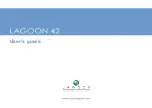
32
July 21, 2012
GENERAL VESSEL OPERATION
Always operate the vessel from the helm station that provides sufficient visibility given
your course, speed, and sea conditions. During docking maneuvers that may require
backing, always operate from fly bridge as there is little visibility astern from the pilot
house. It is best to center the wheel and use only the engines to maneuver the boat
backwards at very slow speeds. It is extremely important that the trim tabs be in the full
up position (bow-up) whenever the boat is maneuvered for docking.
When using engines for steerage, avoid using engines simultaneously in opposite
directions. Although effective, it puts more strain on the drive train than using one
engine at a time. You can almost always attain the desired results by alternate use of
engines or alternating directions on a single engine
When in a harbor or when docking, use only one engine at a time, alternating between
each as needed , The QUE SARA has large 32” props WHICH WILL PUSH THE
VESSEL AT 7 KNOTS with both engines engaged. Always put one engine in gear
and then take it out and observe what effect that had on the vessel before moving to
the next engagement of an engine, this will help you learn the boat and also saty out of
trouble.
If you find yourself in a situation in which you are not certain of what to do, or if a
maneuvering command does not do what you thought it would do Bring the vessel to
a compete stop, stop the motion of vessel and re-group and start over. . The Que
Sara weighs around 70,000 lbs fully loaded and “ motion can cause great damage in
tight quarters.
WINDLASS AND ANCHOR
The anchor windlass uses a large amount of electrical power (90-120 amps). It is always
best to have main engines running when operating the windlass so you retain control of
the boat and minimize battery drain.
NOTE: The Windlass is a powerful machine and can be dangerous to use. Make
sure all crew operating the windlass have been trained how to operate it and to keep
hands, fingers, feet and clothing out of harm’s way.
Windlass controls are at the flybridge helm and at the windlass. Controls at the flybridge
helm may be used if a second person is positioned on the deck to monitor the setting and
conditions. The windlass can also be run from the deck. It is highly recommended the
windlass is controlled from the deck in order to manage the angle of retrieval (always
vertical retrieval) and to make sure the anchor does not swing into the boat.
















































